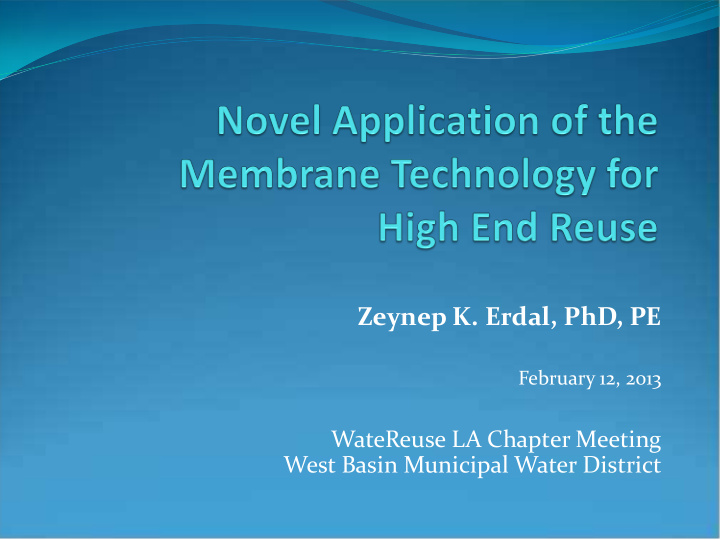



Zeynep K. Erdal, PhD, PE February 12, 2013 WateReuse LA Chapter Meeting West Basin Municipal Water District
Outline Goals Technology Options Pilot Testing Conditions Progress and Status Q&A
Goals Produce recycled water for use in Cooling tower makeup water Boiler makeup water Irrigation Recycled water quality to be suitable for Direct use – non-detectable ammonia N Use as RO feed Waste streams to be In compliance with discharge requirements Minimized to reduce disposal costs
Nitrification Technologies Suspended growth Attached growth 4
Attached Growth Clay or polystyrene media Rope, chip, disks, sponges, etc. media 5
Suspended Growth Conventional activated sludge systems Sequencing batch reactors Membrane bioreactors 6
Membrane Bioreactors (MBRs) Uses low-pressure membrane filtration system (e.g., microfiltration or ultrafiltration) and eliminates the need for clarifiers and filtration for solid-liquid separation Higher MLSS in smaller footprint To clean the exterior of the membranes, backpulsing and air scour is used Tertiary application is relatively new (Hamilton, Canada, CH2M HILL) 7
Membrane Bioreactors (MBRs) Advantages Disadvantages Superior effluent quality Additional cleaning chemicals such as citric Handle WQ variability acid over other Eliminates separate conventional technologies solids/liquid separation Proper maintenance of and tertiary filtration membranes required Pretreatment for NF/RO T-MBR new concept 8
T-MBR Pilot Testing Goals Provide proof of concept for use of a membrane bioreactor for nitrification on a tertiary treated wastewater. Verify the biological system capability to produce less than 1 mg/L ammonia nitrogen. Define and optimize the process design criteria. Take the system to failure and/or test the ability for recovery from failure.
T-MBR Feed Water Quality Average Feed Product Water Parameter Values Requirements pH, SU 6.8 6.5-7.5 Temperature, o C 20 BOD, mg/L 1 TOC, mg/L 12 TSS, mg/L 3 Turbidity, NTU 1.3 <0.2 Ammonia-N, mg/L 53 <1 Nitrate-N, mg/L 11 Alkalinity, mg/L CaCO 3 230 Ortho Phosphate-P, mg/L 0.1 TDS, mg/L 1,560 Monitored Product water is to be also suitable for use as RO feed. 10
Ammonia Oxidation Basics Nitrification ( Nitrosomonas and Nitrobacter ): + + 2 O 2 → NO 3 – + 2H + + H 2 O NH 4 – → 0.021 C 5 H 7 O 2 N + 1.06 + + 1.89 O 2 + 2.02 HCO 3 1.02NH 4 – H 2 O + 1.92 H 2 CO 3 + 1.00 NO 3 Breakpoint chlorination: + + 3 Cl 2 → N 2 (g) + 8H + + 6Cl - 2NH 4 11
Pilot Unit Components
What does the MBR Mixed Liquor Look Like?
MBR System MLSS 3000 2500 2000 MLSS (mg/L) 1500 1000 500 0 17-Dec 27-Dec 6-Jan 16-Jan 26-Jan 5-Feb 15-Feb
60 Influent 50 40 mg N/L NOx-N 30 TKN 20 NH3-N 10 0 1/1/2013 1/6/2013 1/11/2013 1/16/2013 1/21/2013 1/26/2013 1/31/2013 2/5/2013 2/10/2013 60 Effluent 50 40 mg N/ L NOx-N 30 TKN NH3-N 20 10 0 1/1/2013 1/6/2013 1/11/2013 1/16/2013 1/21/2013 1/26/2013 1/31/2013 2/5/2013 2/10/2013
Next Steps Continue monitoring under steady state conditions Conduct challenge tests Develop design criteria for the 12-mgd full scale system
Questions Comments Zeynep.Erdal@ch2m.com
Recommend
More recommend